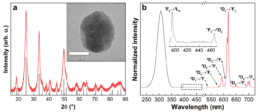SECONDMENT
LUMINESCENT SOL-GEL MATERIALS FOR LUMINESCENCE THERMOMETRY STUDIES
FROM : UNIVERSIDADE DE AVEIRO (PORTUGAL)TO : UNIVERSIDADE ESTADUAL PAULISTA (BRASIL)
FROM : 29 NOVEMBER 2019 TO : 16 DECEMBER 2019
Involved Work Packages :
![]()
RESEARCHER
OBJECTIVES
Luminescence thermometry is useful because it can measure temperature through changes in the photophysical properties of a material. Trivalent lanthanide ions (Ln3+) are commonly used in luminescence thermometry due to their unique optical properties, with narrow long-lived emission bands that cover the entire electromagnetic spectrum. The use of Ln3+ containing nanoparticles in luminescence thermometry is widespread because they can be embedded into different matrix in order to access information concerning the temperature in different media. In this way, this secondment aimed the preparation of silica based luminescent sol-gel materials for mesurement of the temperature through luminescence thermometry.
TASKS
- Synthesis and characterization of luminescent nanoparticles
- Preparation of sol-gel materials containing luminescent nanoparticles
RESULTS
The synthesis of luminescent nanoparticles was performed during the first week of the secondment. Europium doped yttrium vanadate (YVO4:Eu) nanocrystals were obtained through the coprecipitation method, presenting the characteristic red emission of Eu3+ under excitation at ultraviolet light. The Figure 1 shows the characterization performed for the obtained nanoparticles.
Figure 1. X-ray diffraction pattern (red) and reference diffraction peaks (gray) of YVO4:Eu nanoparticles (a). The inset in the panel a shows the TEM image of the obtained nanoparticle. Excitation spectrum monitoring emission at 618 nm (gray) and emission spectrum under 307 nm excitation (red) of the aqueous suspension of the YVO4:Eu nanoparticles (b). The inset in b presents the amplified region of the excitation spectrum.
In the second week, sol-gel materials (Figure 2) were obtained through the imobilization of the obtained nanoparticles into a silica network by using sol-gel methodology. The materials were prepared with different content of nanoparticles and will be studied by luminescence thermometry in order to perform temperature-dependent photoluminescence measurements.
Figure 2. Sol-gel materials obtained during the secondment period. The sample WL is the control, without YVO4:Eu nanoparticles. The samples nWLYEu (n = 1-4) present increasing content of the nanoparticles.
The next steps regarding the project relies on the advanced optical characterization of the materials based on temperature-dependent photoluminescence measurements at CICECO. Another secondment period is expected in order to obtain upconversion luminescent materials.


